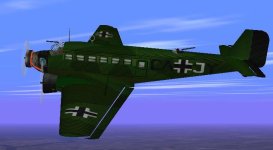aleatorylamp
Charter Member
Armed Ju52/3m WIP
Hello Smilo, Ivan,
At the end, I´ve attached the armed Ju-52 transport/bomber version,
to this post, in case you have the gumption or time to have a look at
it sooner than expected.
I am well aware that you both have a lot to do and may not have the
time for at least a couple of days or perhaps a week or more.
No hurry, and thanks in advance for any obervations, suggestions or
corrections!
Source files are included, but please take into account that the AF99
model is incomplete, also having incomplete elements, because the
finishing stage of the model via SCASM entails a virtual cockpit, a crew
of 2 in the transparent external-view cockpit, as well as completion of
the incomplete elements.
Second thoughts on the canopy display issue in my previous post:
It could also well be normal for transparent surfaces to disappear
depending on the lighting conditions. Normal textures have differnt
colour intensities depending on how the light shines on the surface,
but transparencies probably don´t reflect any light when they are
in a shadow, and become totally transparent.
Cheers,
Aleatorylamp
Hello Smilo, Ivan,
At the end, I´ve attached the armed Ju-52 transport/bomber version,
to this post, in case you have the gumption or time to have a look at
it sooner than expected.
I am well aware that you both have a lot to do and may not have the
time for at least a couple of days or perhaps a week or more.
No hurry, and thanks in advance for any obervations, suggestions or
corrections!
Source files are included, but please take into account that the AF99
model is incomplete, also having incomplete elements, because the
finishing stage of the model via SCASM entails a virtual cockpit, a crew
of 2 in the transparent external-view cockpit, as well as completion of
the incomplete elements.
Second thoughts on the canopy display issue in my previous post:
It could also well be normal for transparent surfaces to disappear
depending on the lighting conditions. Normal textures have differnt
colour intensities depending on how the light shines on the surface,
but transparencies probably don´t reflect any light when they are
in a shadow, and become totally transparent.
Cheers,
Aleatorylamp



